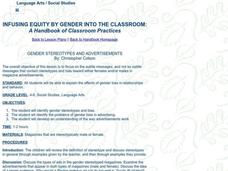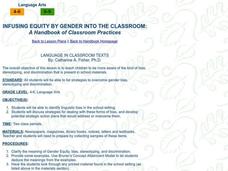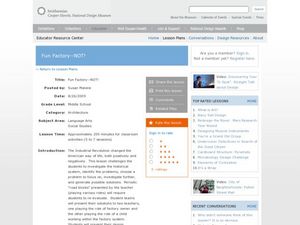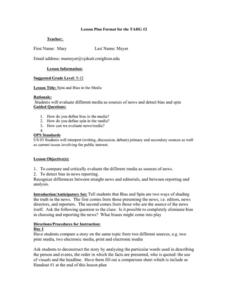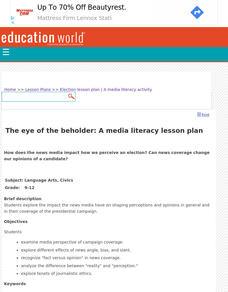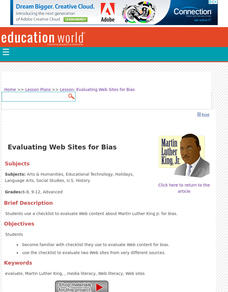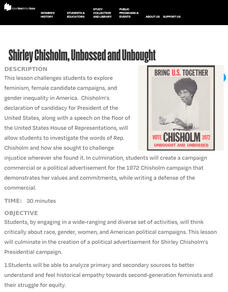Teaching Tolerance
Community Bulletin Board
A project-based lesson has pupils create a bulletin board to share artwork, nonfiction articles, and messages based on social justice themes. The finished board is displayed in the community to create a place for discussion.
Facing History and Ourselves
The 1968 East LA School Walkouts
The East LA School walkouts are the focus of a instructional activity that looks at the importance of an education that honors the culture of all learners. Class members watch videos and read an article on the LA student demands to...
Media Smarts
TV Dads: Immature and Irresponsible?
Examine gender stereotypes on television, focusing on fathers portrayed in sitcoms and advertising. Questions on a handout direct learners to consider the types of fathers they see on television and one advertisement is highlighted as...
Described and Captioned Media Program
Malcolm X: Make It Plain, Part II
Track the transformation of Malcolm Little into Malcolm X and then into El Jajj Malik El-Shabazz with the second part of Make it Plain, a documentary on the famous civil rights activist. Viewers consider not only how events shaped and...
Encyclopedia Britannica
Candidate Flip-Flop or Evolution?
Beware political rhetoric! Connotation is everything! Groups select a presidential candidate and investigate how the candidate's position has changed on a specific issue. After analyzing the situation, the group determines whether they...
Curated OER
Infusing Equity by Gender into the Classroom
Students identify gender stereotypes in magazine advertisements. For this gender bias lesson plan, students discuss the problems of gender bias in advertising and develop an understanding of the way advertisements work.
Curated OER
What is Islam? Who Are Muslims?
Ninth graders discover Muslim beliefs. In this Islam instructional activity, 9th graders identify biases and stereotypes about Muslims. Students then research the cultures and traditions of Muslim nations creating PowerPoint...
Curated OER
LANGUAGE IN CLASSROOM TEXTS
Students gain an understanding and awareness of the bias, stereotyping, and discrimination that is present in school materials. They review everyday printed materials and their textbooks for evidence of gender bias and/or stereotyping.
Curated OER
Fun-Factory - NOT!
Students design a solution to a problem based on the Industrial Revolution. In this design lesson plan, students come up with architectural designs and present them to teachers in a simulated factory.
Curated OER
Spin and Bias in the Media
High schoolers compare different types of media. In this media comparison lesson plan, students will assess the where all types of media gets its information by viewing a video of a news story and critiquing it.
Newseum
Is This Story Share-Worthy?
Young journalists use a "Is This Story Share-Worthy?" flowchart graphic to decide whether a story is worth sharing online. Instructors provide groups with fake news, poor quality stories, opinion pieces, biased news, and high-quality...
Curated OER
Changing Perspectives on the Japanese Internment Experience
Learners explore the issue of Japanese-American internment. In this World War II lesson, students analyze historical biases regarding Japanese-American internment as they analyze literature, research print and Internet sources, and...
Facing History and Ourselves
Citizen Watchdogs and the News
To conclude their case study of media coverage of the shooting of Michael Brown by a Ferguson, Missouri, police officer, class members consider the role of citizen watchdogs in a democratic society, develop strategies for combating...
Curated OER
The Eye of the Beholder: A Media Literacy Activity
Learners explore the impact the news media have on shaping perceptions and opinions in general and in their coverage of the presidential campaign.
Museum of Tolerance
Influence of Media
We are bombarded with media images expressly designed to influence viewers. Learning how to analyze the intended effects of these images is essential and the focus of an activity that asks viewers to use the provided questions to guide...
Crafting Freedom
F.E.W. Harper: Uplifted from the Shadows
Young historians discover the life of an incredible African American woman who, as an anti-slavery lecturer prior to the Civil War, defied stereotypes of what women could accomplish. Pupils explore the concept of stereotyping, read...
Curated OER
Evaluating Web Sites for Bias
Students become familiar with checklist they use to evaluate Web content for bias. They use the checklist to evaluate two Web sites from very different sources.
Curated OER
Phenomenology Lesson Plan #1
Students approach media with a phenomenological criticism. They recongize biases that they have and where they have come from. They also identify biases in professional work.
Curated OER
Phenomenology Lesson Plan #2: Content Part #1
Students examine different types of media. They identify the bias in film and share them with the class. They also examine their personal biases and write about them.
Curated OER
Exploring Media: Understanding and Identifying Editorial Perspective in Television and Radio News
Students research the topics Boat People: A Refugee Crisis, Dr. Henry Morgentaler: Fighting Canada's Abortion Laws, and CANDU: The Canadian Nuclear Reactor on the CBC Radio and Television Archives Web site.
Library of Congress
The Emancipation Proclamation and the Thirteenth Amendment
How did the Emancipation Proclamation lead to the Thirteenth Amendment? Middle schoolers analyze primary source documents including the text of the Emancipation Proclamation, political cartoons, photographs, and prints to understand...
iCivics
Drafting Board: Interest Groups
Does the influence of interest groups harm a political system? Your class members will analyze the role of interest groups in American politics, as well as consider the effect of perspective, bias, loyalty, and the...
National Woman's History Museum
Shirley Chisholm, Unbossed and Unbought
An engaging resource introduces young historians to Shirley Chisholm, the woman, the Black congresswoman, the activist, and the candidate for President in 1972. Class members study primary sources, watch a video of her announcing her run...
Curated OER
Gender Role Development
Students look in newspapers and magazines and discuss gender role development and stereotypes. In this gender lesson plan, students bring in their favorite objects that have no gender stereotype linked to it.







